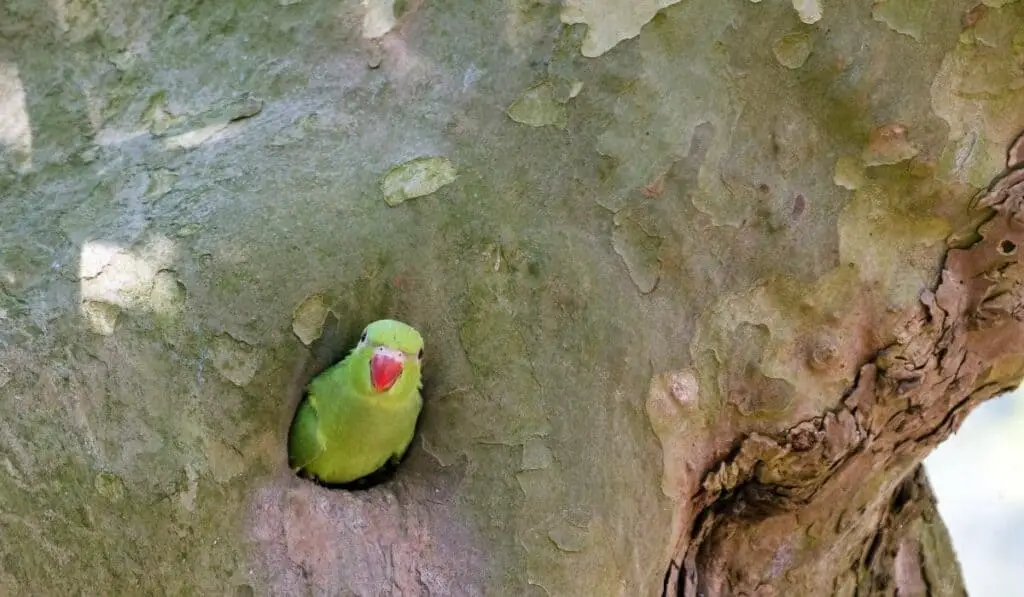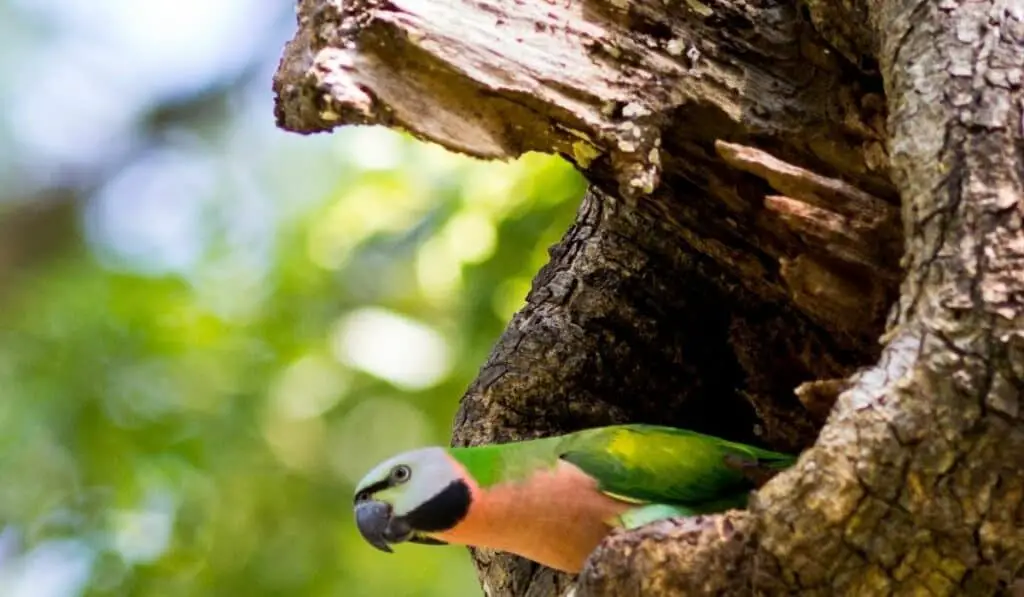If you’re preparing to get a pet parakeet, you may be pondering over whether or not your parakeet needs a nest or nest box. Knowing what to buy and what not to buy for a new pet, especially a pet that is not as common as a cat or a dog, can be perplexing.
The question is, does a domestic parakeet that has all the comforts of life provided by a human caretaker really need a nest? Do they sleep in one, breed in one?
Parakeets need a nest for breeding, resting, and privacy. Domestic parakeets do not build nests, so one will need to be provided for them in captivity. In the wild parakeets will use hollow trees and other places to rest. Breeding parakeets need a special nesting box, a place where they can lay eggs and protect them.
Table of Contents
What kind of nest does a parakeet need?
In the wild, the majority of parakeets build their nests in holes in trees. However, the Monk Parakeet builds a bulky stick nest in the branches of a tree, for sleeping in and for raising its young.
In captivity, nothing this elaborate—or traditionally nest-y—is necessary. Parakeets are low maintenance birds and do not require a conventional nest; they simply need somewhere for privacy and rest.
Your parakeet will be happy with a small enclosure inside its cage that it can go inside, be unseen, and get some sleep. An excellent choice is a small hut with a soft sleeping mat inside.

What does a pet Parakeet need besides a nest?
First, the bigger the parakeet cage, the better. Opt for the largest enclosure in your budget and that you have space for in your home. The cage should be no smaller than 18” x 18” x 24” and should have several perches for your parakeet to stand on.
We like the Prevue Hendryx Cage from Amazon ( Link )
Line the aviary with bedding made of recycled paper, or you can use a specific cage liner. Replace the lining no less than every other day; parakeets despise an untidy living environment.
Place your parakeet’s cage below eye level and away from the kitchen and any windows. Parakeets have a sensitivity to smoke and strong odors, so they should be kept safely away from anywhere they could be exposed to such irritants. A nest box is another way to escape the bright light or sunshine.
Your parakeet also needs food, water, and toys in their cage.
A parakeet should eat a balanced diet of pellets, bird seed blend, fresh fruits and vegetables, treats, and plenty of water, which should be changed every day.
The types of toys parakeets enjoy playing with are bells, chew toys, puzzles, creative/fun perches, ladders, and swings.
Cuttlebone
A cuttlebone is also something important for a parakeet to have in their cage. Parakeets use cuttlebones to smooth their growing beak, almost like a nail file for humans. It also provides nutrients that are otherwise difficult for your parakeet to get in their diet.
Some people have concerns about letting their parakeets have cuttlebones, but it’s a 100% natural product; it’s the endoskeleton, or inner bone, of a cuttlefish. The Humane Society has ruled that it is entirely safe for parakeets to have cuttlebones.

Parakeets Sleeping Habits
In captivity, parakeets typically sleep on the same schedule as their caretakers and nap during the day, much like cats or dogs. However, parakeets are a bit finicky over sleeping conditions, and there are a few things that will affect the quality of a parakeet’s sleep:
- Parakeets don’t like total darkness—Either get them a night light or don’t cover their cage completely at night.
- Parakeets scare easily by loud noises—Make sure they have somewhere quiet to rest and try not to make loud, abrupt sounds while they’re sleeping.
- Parakeets do not like messy cages—Clean their cage regularly, or you will get some sass from your parakeet.
- Parakeets do not like it too cold or too hot—Keep the temperature in their cage environment from 70°-80°F.
Other than that, it’s quite simple, parakeets like a quiet, private, warm place to cuddle up and sleep. As long as you’ve provided a comfortable nest for your parakeet and you make sure that it has prime sleeping conditions, your parakeet should rest easily.
You should make sure that your parakeet gets enough rest (9-12 hours per day) because it will get cranky if it doesn’t. A soft sleeping nest like the Keeris Soft nest box on Amazon will provide a safe, warm, and dark place to rest or sleep.

Do you need a nest or nest box to breed Parakeets?
Yes, parakeets can breed in captivity. It’s not very difficult. Under the optimal conditions, parakeets will breed with little encouragement from their caretakers.
Two parakeets of the opposite sex in a cage together will typically pair up, but if it does not happen right away, give it a few days before intervening.
Some pairs of parakeets chosen to mate will fail to bond after having been stuck in a cage together. It’s common for a fail-bond pair to be defensive and hostile towards one another. In this case, take a step back and reconsider your matchmaking. Re-pair your parakeets and try again.
Breeding Season
The parakeet mating season is during the wet spring season and the summer. Still, parakeets in the northern United States breed during the entire year. However, they do need daylight hours to trigger the mating instinct.
Breeding Age
Parakeets mature to breeding age at around six months, but you shouldn’t breed them until at least ten months. You should not breed a parakeet at six months because they aren’t ready to be good parents just because they have reached physical maturity; they still have brain development to finish, and they need to reach mental maturity, which doesn’t happen until at least ten months.
Nesting Requirements
A parakeet breeding cage’s dimensions should be no less than 25” x 15” x 15”. The breeding pair should be in this cage alone, away from all the other parakeets. The breeding cage should have all of the cage amenities detailed in the sections above, plus a nesting box, which you should affix to the side of the cage.
Just as with nests, in the wild, parakeets breed in holes in trees. For successful breeding in captivity, you need to simulate a hole in a tree—nesting boxes made of wood with holes for the parakeets to enter and exit work perfectly for this.
You should line the inside of the nesting box with something for the female to lay her eggs on, such as soft nesting material.
Some parakeets won’t use the nesting box and will lay eggs on the floor of their cage. You can teach your parakeet to use the nesting box by placing her eggs inside the nesting box to show her that’s where she should lay her eggs in the future.
Parakeet Nesting Behaviors
When your parakeet becomes a parent, its behavior will likely change. Like any parent in the animal kingdom, parakeets experience the natural instinct to protect their young. Hormones that parakeets begin to release when protecting their eggs cause them to display increased aggression rather commonly.
You should avoid handling your parakeet during this stage of early parenthood. Over time, the hormones will subside. Your parakeet will return to the personality it had before becoming a parent; it may even allow you to play with its babies.
Final Thoughts
A nest is a place where your parakeet can feel safe and secure. They will not build one so remember to buy a suitable nest box or build one yourself if you want you parakeet to relax and enjoy their home.





